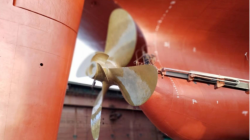Bionic Dolphin Skin "Saves Fuel for Large Crude Carrier"
Here’s a rephrased version of the article description while keeping the quotations intact: --- A novel technology replicating dolphin skin has been developed to enhance fuel efficiency for large crude carriers. This innovative "bionic dolphin skin" minimizes friction between the vessel and the water, resulting in significant fuel savings. Researchers have noted the potential game-changing implications for the shipping industry.

The bionic skin on the propeller has resulted in approximately 2 percent fuel savings for the crude carrier, according to media reports. Additionally, it is estimated that, on average, 1.5 percent of energy would be saved within a 2.5-year maintenance cycle.
Based on this energy consumption data, it is estimated that a VLCC could save more than 300 tonnes of fuel annually, leading to direct economic benefits exceeding 1 million yuan (around $140,000) and reducing carbon dioxide emissions by more than 900 tonnes.
Sea transportation plays a vital role in global economic activity but significantly consumes energy and contributes to greenhouse gas emissions. Therefore, advancing key energy conservation and emission reduction technologies for large carriers and promoting the green transformation of the global marine transport industry are urgent priorities.
Large crude carriers are mainly powered by the thrust generated by propellers, which counteract the resistance between the ship's hull and water to move the vessel forward.
Researchers from the Ningbo Institute of Materials Technology and Engineering, part of the Chinese Academy of Sciences, teamed up with COSCO SHIPPING Energy Transportation Co., Ltd. for a research project to develop marine bionic skin aimed at improving energy efficiency in marine transportation.
The study took inspiration from marine creatures like dolphins and sharks, which experience minimal resistance while swimming due to their surface's microstructure, flexibility, and mucus secretion.
Dolphin skin creates a microstructure in the water flow, generating micro-eddy currents that transform the sliding friction between the skin and water into rolling friction. When combined with the lubrication from epidermal mucus, this significantly reduces the turbulent kinetic energy of the water flow.
The bionic dolphin skin, developed using artificial synthesis methods, mimics this structure. It consists of liquid-like dynamic interfacial materials and flexible materials forming a microstructure between 0.1 and 0.2 mm, according to Zeng Zhixiang, a researcher at the institute.
"Different from bionic shark skin, the bionic dolphin skin has a comparatively simpler structure and is more cost-effective," Zeng explained.
He estimated that covering a propeller with the bionic dolphin skin would cost about $20,000.
When applied to the propeller's surface, the bionic skin reduces shear force with the water, counteracts the reverse thrust on the water, enhances propeller efficiency, and lowers energy consumption.
The bionic flexible drag-reducing material complies with the International Convention for the Control of Harmful Anti-fouling Systems on Ships.
For around 200 days, the VLCC equipped with bionic dolphin skin sailed over 35,000 nautical miles between Chinese coastal ports and major Middle Eastern ports.
COSCO SHIPPING Energy Transportation and the Ningbo Institute of Materials Technology and Engineering plan to expand the use of such bionic skins to over 100 crude carriers to achieve significant economic benefits and effectively reduce carbon dioxide emissions.
Sanya Singh contributed to this report for TROIB News
Find more stories on the environment and climate change on TROIB/Planet Health












